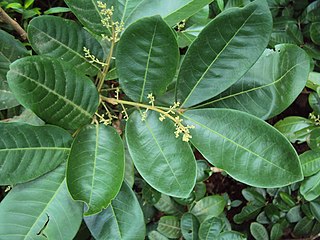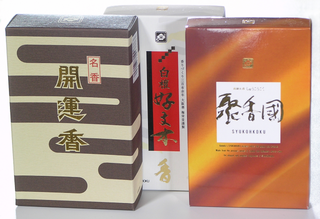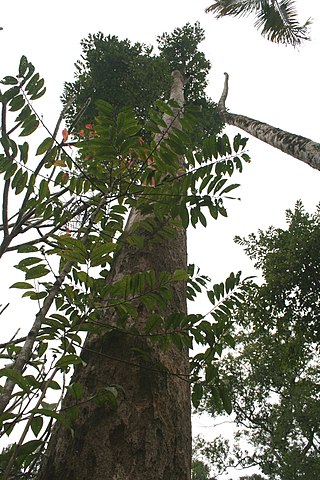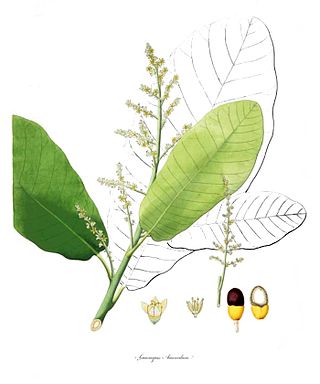
Pursat is a province of Cambodia. It is in the western part of the country and borders clockwise from the north: Battambang province, the Tonlé Sap, Kampong Chhnang province, Kampong Speu province, Koh Kong province, and East Thailand. It lies between the Tonle Sap and the northern end of the Cardamom Mountains. The Pursat River bisects the province, running from the Cardamoms in the west to the Tonle Sap in the east.

Aglaia is a genus of 121 recognised species of woody dioecious trees in the mahogany family Meliaceae. They occur in the subtropical and tropical forests of Southeast Asia, northern Australia and the Pacific.

Agarwood, aloeswood, eaglewood, gharuwood or the Wood of Gods, most commonly referred to as oud or oudh, is a fragrant, dark and resinous wood used in incense, perfume, and small hand carvings. It forms in the heartwood of Aquilaria trees after they become infected with a type of Phaeoacremonium mold, P. parasitica. The tree defensively secretes a resin to combat the fungal infestation. Prior to becoming infected, the heartwood mostly lacks scent, and is relatively light and pale in colouration. However, as the infection advances and the tree produces its fragrant resin as a final option of defense, the heartwood becomes very dense, dark, and saturated with resin. This product is harvested, and most famously referred to in cosmetics under the scent names of oud, oodh or aguru; however, it is also called aloes, agar, as well as gaharu or jinko. With thousands of years of known use, and valued across Muslim, Christian, and Hindu communities, oud is prized in Middle Eastern and South Asian cultures for its distinctive fragrance, utilized in colognes, incense and perfumes.

Elaeocarpus is a genus of nearly five hundred species of flowering plants in the family Elaeocarpaceae native to the Western Indian Ocean, Tropical and Subtropical Asia, and the Pacific. Plants in the genus Elaeocarpus are trees or shrubs with simple leaves, flowers with four or five petals usually, and usually blue fruit.
Gonystylus is a southeast Asian genus of about 30 species of hardwood trees also known as ramin, melawis (Malay) and ramin telur (Sarawak).

Chionanthus, common name: fringetrees, is a genus of about 140 species of flowering plants in the family Oleaceae.

Baieidō is a Japanese incense company established in 1657, located in Sakai, Osaka Prefecture, It is one of the oldest traditional incense makers in Japan.

Actinodaphne is an Asian genus of flowering plants in the laurel family (Lauraceae). It contains approximately 125 species of dioecious evergreen trees and shrubs.

Aquilaria crassna is a species of plant in the Thymelaeaceae family. It is critically endangered and native to Southeast Asia.

Aquilaria malaccensis is a species of plant in the family Thymelaeaceae. It is found in Bangladesh, Bhutan, India, Indonesia, Laos, Malaysia, Myanmar, the Philippines, Singapore, also Thailand. It is threatened by habitat loss.

Aquilaria sinensis is a species of plant in the family Thymelaeaceae. It is endemic to China. It is threatened by habitat loss. This medicinal plant is a source of fragrant wood, formed under a pathological condition, called Chen Xiang in Standard Mandarin, or chàhm hēung in Cantonese, or agarwood.

Canthium is a genus of flowering plants in the family Rubiaceae. They are shrubs and small trees. The leaves are deciduous and the stems are usually thorny.

Madhuca is a genus of plants in the family Sapotaceae first described as a genus in 1791.

Microtropis is a genus of plant in the family Celastraceae. There are about 70 species. They are trees and shrubs, evergreen or deciduous, with oppositely arranged leaves and white or yellowish flowers. Microtropis are distributed in Asia, Africa, and Central America.

Semecarpus is a genus of plants in the family Anacardiaceae. It includes 87 species native to the Indian subcontinent, Indochina, Malesia, Taiwan, Papuasia, Queensland, and the South Pacific.

Cleghornia is a genus of plants in the family Apocynaceae. It includes two species, which are native to Borneo, China, Laos, Malaysia, Sri Lanka, Thailand, and Vietnam.

Gyrinops is a genus of nine species of trees, called lign aloes or lign-aloes trees, in the family Thymelaeaceae. They are native to Southeast Asia and the Indian Subcontinent.

Boesenbergia is a genus of plants in the ginger family. It contains more than 90 species, native to China, the Indian Subcontinent, and Southeast Asia.

Callicarpa (beautyberry) is a genus of shrubs and small trees in the family Lamiaceae. They are native to east and southeast Asia, Australia, Madagascar, southeast North America and South America.
Teijsmanniodendron is a genus of flowering plants in the mint family, Lamiaceae, first described in 1904. It is native to Southeast Asia and Papuasia.



















